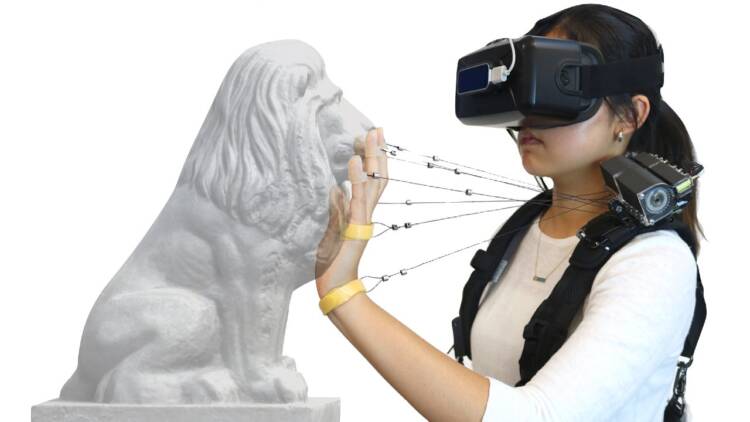Taste and Touch Are the Next Frontier for Virtual Reality Porn
Innovations in sensation that could transform adult entertainment.

Sprinkled with gently iridescent water droplets, the firmly red and vividly juicy apple entices you. Falling victim to temptation, with taste buds readily anticipating its tarty sweetness, the firm crunchiness, you reach out and pick it up.
In your hand, the fruit’s waxy skin yields stiffly, your thumb depressing into the resistant flesh when you apply pressure. Stomach growling, you finally take a bite: filling your eagerly anticipating mouth with a burst of bright, shimmering flavor.
Then, after enjoying the apple down to its inedible core, you remove your virtual reality goggles and get back to living in the so-called real world.
An excuse to indulge in some purple-prose aside, this level of VR immersion may not be that far off: boosted by a recent pair of technological advancements that have given users tactile sensations—and even the illusion of taste.
A new take on haptic feedback
By now we’re all pretty much getting used to announcements of this-or-that new approach to granting virtual reality users a way to feel and not just see.
Only a few months ago, we covered how researchers at the University of Sussex in Brighton, England found that they could use a previously unexplored aspect of ultrasonic sound to do just that.
Others, meanwhile, have focused on various other angles to the same problem, including using electrostimulation to trick our nerves into thinking we’re in contact with something, or someone.
Skinterface, meanwhile, is less potentially shocking as it uses magnets imbedded in a special garment to deliver pressure sensations to the wearer.
Compared to these and other avenues of research, Carnegie Mellon University’s Wireality may at first seem overly mechanical. But according to the team developing it, their system may be just the thing to give virtual reality a sense of touch.

As the lead engineer, Cathy Fang, put it on the project’s homepage:
“[Wireality] Enables tangible interactions with complex geometries, such as touching non-perpendicular, flat, and curved surfaces, wrapping fingers around railings and poles, and touching irregular objects.”
How it does this is through a network of cables attached to gloves and leading back to a shoulder-mounted servo array.
After being integrated into VR, when the user reaches out towards a digital object, Wireality responds by pulling on one of those cables giving a haptic illusion of touching what’s only there virtually.
Fang, along with Yang Zhang, Matthew Dworman, and Chris Harrison, point out that unlike other technologies theirs shows real promise for commercial use, as Wireality is “fast-acting, spatially-accurate, high-strength, comfortable, and immersive.”
Tasting electronically

Meanwhile, 5,938 miles away, Homei Miyashita of Meiji University was working on another sense to bring to virtual reality.
The basis of Miyashita’s technology is electrophoresis which, thank you Wikipedia, involves “using the motion of dispersed particles relative to a fluid under the influence of a spatially uniform electric field.”
Practically, it’s a piece of hardware containing five chemical gells, for each of the five tastes, that when licked provides a remarkably accurate illusion of any kind of food imaginable, including “the flavor of everything from gummy candy to sushi without having to place a single item of food in their mouths,” as Miyashita put it in an article from Fantastical Futurist.
Taking a bite of a sexy apple
Cathy Fang and her team may not have envisioned Wireality as anything other than a method for virtual reality users to reach out and touch objects.
According to Miyashita, the flavor technology was inspired by allowing people to share the taste of without the risk of contracting a disease.
These technologies could have a huge impact on the adult entertainment industry.
Beginning with Wireality, that it can react immediately is a major plus over other forms of haptic feedback technology that might suffer from unpleasant software delays.
And we can’t discount that it might be a much more affordable option compared to others that might provide better tactile resolution but with a far steeper price tag.
Of the two, Miyashita’s flavor technology is the one that really raises eyebrows. Despite the fact that it might require the wearing of something similar a mouthguard for it to work, that it could supply that woefully under-considered aspect what makes something sexually arousing would be more than worth it.
What with taste being such a turn on for so many, it could also be built and sold as a separate device: a nifty little pocket-sized gizmo programmed to deliver every kind of sexual flavor imaginable or a combination of many, like an erotically charged smorgasbord.
Once perfected, sex tech companies might jump on the Miyashita flavor tech as well. Who, after all, wouldn’t want a toy that tastes realistically, as well as looks and feels lifelike?
The adult industry is always been behind the wheel
It’s kind of funny that both these researchers haven’t, at least not yet, openly considering their tech in explicit virtual reality games and products.
Certainly, adult entertainment still has a bit of a reputation problem among those not in the industry, but anyone with any level of experience with technological development knows that a major driver of getting anything out into the world, and then widely accepted, is if it can be used to turn people on.
Here’s hoping that someday soon these and other development teams will smell the coffee, taste victory, savor success, hear cash registers ring, and see their inventions become part of everyone’s day-to-day lives.
All due to their final acceptance that sex, virtual or otherwise, isn’t a forbidden fruit but rather has always been a wise decision in developing and marketing new technologies.
Image sources: 明治大学 宮下研究室, CATHY FANG
Leave a reply
You must be logged in to post a comment.

















